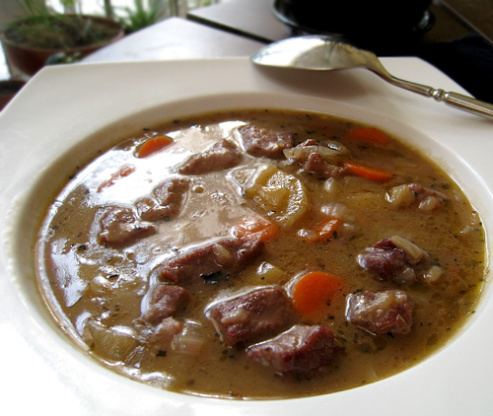Type Soup | Place of origin Great Britain | |
 | ||
Main ingredients Lamb or beef steak, parsnips, carrots, leeks, bouquet garni, Madeira wine Similar Squab pie, Malvern pudding, Singing hinny, Sussex pond pudding, Cornish fairing | ||
How to pronounce brown windsor soup
Brown Windsor soup is a British meat soup that is said by conventional wisdom to have been popular during the Victorian and Edwardian eras.
Contents
Origins and history
It is unclear whether this often-written-about soup is of Victorian origin. The food writer Alan Davidson in The Oxford Companion to Food (2006) refers to an elaborate late Victorian recipe in Garrett's Encyclopedia of Practical Cookery from 1890, although Davidson does not make clear if Garrett's recipe is for a "Brown" Windsor Soup. The earliest known cases of "Brown Windsor soup" are found in restaurant menus published as advertisements in newspapers during the 1920s and 1930s. Examples include Cadena Cafes (Portsmouth) which advertised "Soup - Tomato or Brown Windsor" on its menu dated 24 February 1926. Bobby's of Queens Road (Bristol) advertised "Potage Brown Windsor" (under the "soup" heading) on its menu dated 13 February 1931. The Scottish department store Isaac Benzie advertised "Brown Windsor Soup" in a menu published 14 December 1933.
Some more recent web sources incorrectly claim there are no references to "Brown Windsor soup" prior to a joke mention, or invention, in the 1953 Ealing Studios film comedy The Captain's Paradise. Another associates it with Calves' Feet Soup à la Windsor, created for the "post-natal Queen Victoria" by Charles Elmé Francatelli, her chef. Etymologist Michael Quinion incorrectly states the earliest known reference is from 1943, in The Fancy, by Monica Dickens. Nevertheless, Quinion speculates on three theories: that Brown Windsor soup may be confused with White Windsor soup, a type of soup which unquestionably existed in the nineteenth and early twentieth centuries appearing on many menus. Or it may be confused with Brown Windsor soap, which also existed in this period. Or finally it may be a mashup term conflating White Windsor soup with Brown Windsor soap. In any case, "it became shorthand for awful food," and was used as a prop by comics in the post war years. In short, Quinion suggests at least three possible theories as to the origin of the name and posits that resolution awaits further research.
As to the name, a few early White Windsor soup recipes included the use of Windsor fava beans (broad beans), perhaps the origin of the name. Quinion says there is no connection to the royal family itself since Windsor soup predates 1917, when the family changed its name from Saxe-Coburg-Gotha to Windsor. He also adds that fictional barrister Rumpole of the Bailey mentioned eating it on the Great Western Railway in a book of short stories dated 1978 — although Quinion questions whether this is an endorsement of the soup, "the extract confirms that the soup was at one time a staple of the restaurant menus of British Railways." Though Dr Malcolm Timperley, a researcher in the National Railway Museum's library and archives, reports that their team has specifically researched the existence of brown Windsor soup in British dining cars. After checking scores of menus dating back to the nineteenth century they failed to find any mention of it.
Despite its disputed origins, there are many recipes, and they often reassert or embellish the supposed myth.
In popular culture
British magazine The Poke sold a satirical can of Brown Windsor Soup as part of a "Jubilee Collection," available for about ₤40, complete with Silver spoon and reportedly made "directly from the sewage outflow of Windsor Castle." Brown Windsor soup is identified in the film "Carry On Regardless" (1961) by Kenneth Connor as the dish he is splashed with having knocked over a waiter's tray on a train and in Carry On Abroad (1972) by Kenneth Williams in a scene in a restaurant. In an episode, titled The Macreekie Rising of '74, of The Goon Show, Brown Windsor Soup is used as a weapon and mocked as "deficient in calories" by the impressively stout Neddy Seagoon. In Hancock's Half Hour, episode "Air Crew Only", the in-flight meal starts with "Brown Windsor soup just burnt enough to leave that attractive brown ring sticking round the edge of the plate" In Agatha Christie's Poirot, episode "Hercule Poirot's Christmas", Poirot laments to a waiter that the Brown Windsor Soup he has been served "doesn't look very... delicieux". In "Basil the Rat," the last episode of Fawlty Towers, the upper-class couple who have the rat under their table order a Windsor Soup as their starter.
